The woman in Problem 24 has had two miscarriages. She has come to you, an established genetic counselor, with these questions:
Is there a genetic explanation of her frequent miscarriages?
Should she abandon her attempts to have a child of her own?
If not, what is the chance that she could have a normal child? Provide an informed response to her concerns.






